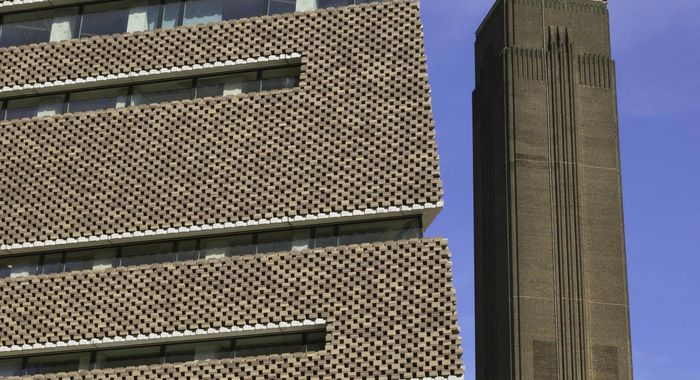Article: Maria Balshaw, the first woman at the top of the Tate: 'We need to speak to the whole of society'
I don’t feel daunted’ … Balshaw, with (from left) Frances Morris of Tate Modern, Alex Farquharson of Tate Britain, Francesco Manacorda of Tate Liverpool and Anne Barlow of Tate St Ives. Photograph: Peter Nicholls/Reuters
(Article originally published by The Guardian here, Friday 7 July 2017 10.35 BST)
The terror attacks, Grenfell Tower, the election: the Tate’s new boss has not had a quiet easing-in period. But she’s determined to make the galleries central to these tumultuous times
Maria Balshaw, newly appointed director of Tate, has been in post for just three and a half weeks when we meet. Despite nursing an ill-timed broken arm, a yoga injury (“someone was doing a handstand and they fell on top of me”), Balshaw is on fine form. Reflective and precise, she wears her position of influence in the art world with grace – and a silk printed Duro Olowu kimono.
Ordinarily, the new head of a national arts institution might expect to spend their first few weeks figuring out internal politics and memorising names, but what might have been Balshaw’s easing-in period has included the Borough Market terror attack, a snap general election, the Grenfell Tower fire and the Finsbury Park mosque attack. Before that, there was the Manchester Arena bombing, significant for many reasons, but also because Balshaw has come to London after 11 years at the forefront of Manchester’s arts scene, where she was the director of the Whitworth Art Gallery and Manchester City Galleries, as well as director of culture for Manchester city council.
The Borough attack, close to Tate Modern in London, happened on her third day in the job: “Staff who finished at 10 o’clock at Tate Modern came out into it all. Everyone was safe, thankfully, but they were caught up in the aftermath,” she says. Balshaw spent her first Sunday with the Tate Modern director, Frances Morris. “We decided together to stay open, to say we are for tolerance, we are against that kind of fear-making, and also we will keep everyone safe. So I watched visitors thanking staff for searching their bags as they came in.”
(Sothiou, 2017, a self-portrait by Khadija Saye, who died in the Grenfell Tower fire, from her Venice Biennale series Dwelling: In This Space We Breathe, on display at Tate Britain. Photograph: Khadija Saye)
When she got home that evening, Balshaw wrote to colleagues running arts organisations along the Thames – Jude Kelly, artistic director at the Southbank Centre, Rufus Norris at the National Theatre, and others, as a gesture of unity and support. “By 12 o’clock the next day we’d issued a joint statement saying: ‘We are horrified, but we are open, and we are for the spirit of London and its people.’”
It is only afterwards that this strikes me as a bold move for the newbie in town – she has taken over from Nicholas Serota, who held the post for almost three decades, overseeing a period of expansion, including the opening of Tate Modern and Tate St Ives. But Balshaw is known as much for her charm as for her capacity to get things done. While at the Whitworth she raised more than £15m for an ambitious renovation. She also has a reputation for being warm, accessible and good at managing egos.
Publicly funded arts institutions should come into their own in tumultuous times, says Balshaw. “It’s not about taking positions left or right politically, but about holding a space where things that are at issue in our world can be explored, because that’s what artists do.” You can’t separate “the arts” or “artists” from events that are going on around them. Something like the Grenfell Tower fire “touches us as arts organisations because we’re part of a city”, she says, speaking of the decision to display work by the artist Khadija Saye, who died in the fire.
Tate curator Andrew Wilson knew Saye well and had been working with her for the past three years. The work is displayed in her memory, and for all who lost their lives: “That’s what an arts organisation should do when somebody who had such extraordinary creative potential has been lost,” says Balshaw.
(All in the frame … Art Is (Girlfriends Times Two), 1983/2009, by Lorraine O’Grady Photograph: © Lorraine O’Grady Courtesy of the artist and Alexander Gray Associates, New York
© Lorraine O’Grady)
Much has been made of the fact that she is Tate’s first female director in the organisation’s 120-year history. “It both matters and doesn’t matter,” she says. “I got bought a Spare Rib diary when I was 13 years old, and the trajectory I’ve taken through life was defined by great feminist writers like Alice Walker, Kate Millettand Germaine Greer. But Some of Us Are Brave [a collection of African American feminist essays] was the most important book I read when I was a student, so I’m completely fine with being a feminist.”
But she is, quite understandably, at pains to point out that she got the job because she is the best person for the role: “And therefore my gender doesn’t matter at all.” The focus on her appearance and her fashion savvy is already beginning to grate: “The media makes more of my clothes than if it was a recently appointed male at another national museum in London.” If the banging on about her shoes is a mild irritant, being constantly asked if she’s “feeling daunted” is even more galling, as it implies she’s somehow in above her head.
“One of the great things about coming to London now is that nearly everybody is pretty new in the national museums,” she says, “Gabriele Finaldi has only been at the National [Gallery] not quite two years, Nick Cullinan is still quite new at the National Portrait Gallery, Hartwig Fischer is very new at the British Museum, and Tristram [Hunt] is as new as me at the V&A. I bet if you look across the interviews, I doubt they’ve been asked that question. And I don’t feel daunted – I feel tremendously excited.” That said, she is moved when younger women in the museum and galleries world approach her and tell her how important her appointment is: “So it doesn’t matter and it really matters.”
I first encountered Balshaw in Manchester in 2011, when she was curating We Face Forward. A big exhibition of west African contemporary art, it took its title from the quote by Kwame Nkrumah, the first president of independent Ghana: “We face neither east nor west; we face forward.” The show could easily have been a stereotypical mishmash, but it was dynamic, groundbreaking and subversive. It was also the first time the city’s two principal galleries (the Whitworth and Manchester City Galleries) had jointly curated a large exhibition.
(Pivotal figure … Pittsburgh Memory by Romare Bearden. Photograph: Romare Bearden Foundation/DACS London)
Showing work by leading African artists such as El Anatsui, Meschac Gaba and Romuald Hazoumè, We Face Forward made direct links between the city’s colonial legacy and cotton mill history. Balshaw has a collaborative spirit, and the knack of getting artists to trust her. She thinks about art in relation to the structures of inequality and has a finely tuned sense of how power, identity and the arts collide.
While doing a PhD in African American visual and literary culture at Sussex University, she studied the Harlem Renaissance: “My thesis ended with Isaac Julien’s [film] Looking for Langston and Toni Morrison’s novel Jazz.” She was also hugely influenced by Paul Gilroy’s book The Black Atlantic. “That was the theoretical framework for what I was doing,” she says. It is great timing, then, that the first exhibition to open at Tate Modern on her watch is the forthcoming Soul of a Nation: Art in the Age of Black Power.
Soul of a Nation asks what it meant to be a black artist in the US during the civil rights era and at the birth of the Black Power movement...
For full article, please see here.

